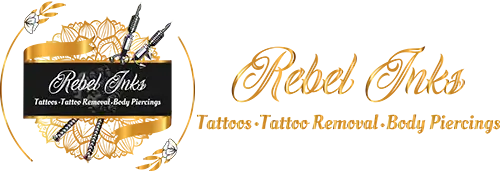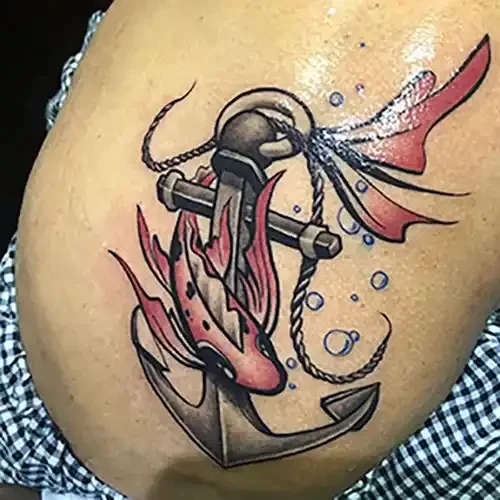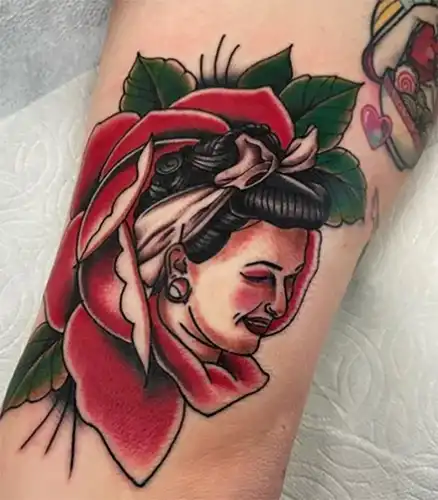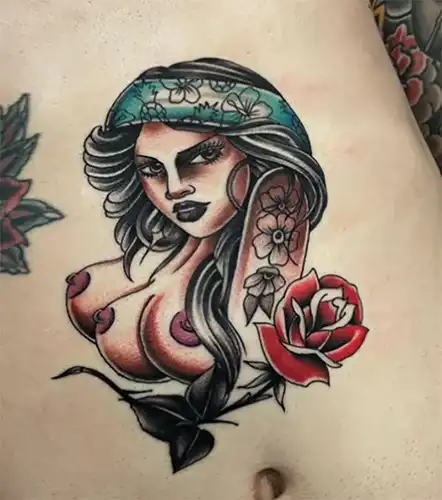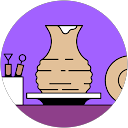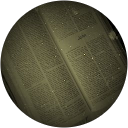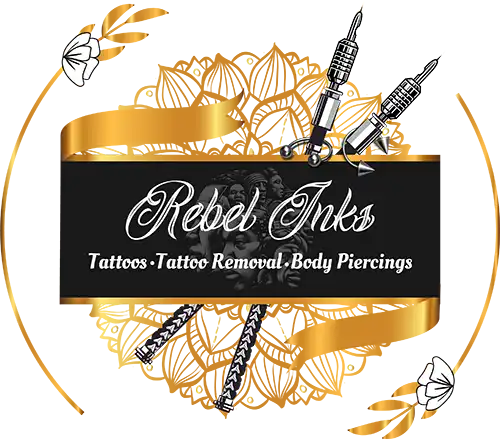Old School Tattoos in Nairobi, Kenya
Old School Tattoos, also known as traditional tattoos or American traditional tattoos, are a style of tattooing that originated in the late 19th and early 20th centuries. These tattoos are characterized by bold, simple designs with a limited color palette and heavy black outlines. They often depict classic symbols such as anchors, roses, daggers, skulls, swallows, hearts, and nautical imagery.
Old school tattoos were commonly seen on sailors, soldiers, and working-class individuals. The style has a distinctive look that has stood the test of time and continues to be popular today.
Old School Tattoos
Key features of old school tattoos include:
- Bold Outlines: Old school tattoos typically have thick, black outlines that help define the design and make it stand out.
- Limited Color Palette: Traditional tattoos traditionally use a limited color palette, including bright primary colors like red, blue, and yellow.
- Iconic Symbols: Old school tattoos feature iconic symbols such as anchors, swallows, roses, hearts, mermaids, pin-up girls, and skulls. These symbols often carry specific meanings and symbolism.
- Solid Fill: The color in old school tattoos is solid and doesn’t involve intricate shading or gradients. The colors are applied evenly and give the tattoo a bold appearance.
- Patriotic and Nautical Themes: Many old school tattoos have patriotic or nautical themes, reflecting their popularity among sailors and servicemen. These themes include eagles, ships, compasses, and flags.
Old School Tattoos Design Techniques
Old school tattoos are characterized by specific techniques that contribute to their distinct look and style. Here are some key techniques commonly used in creating old school tattoos:
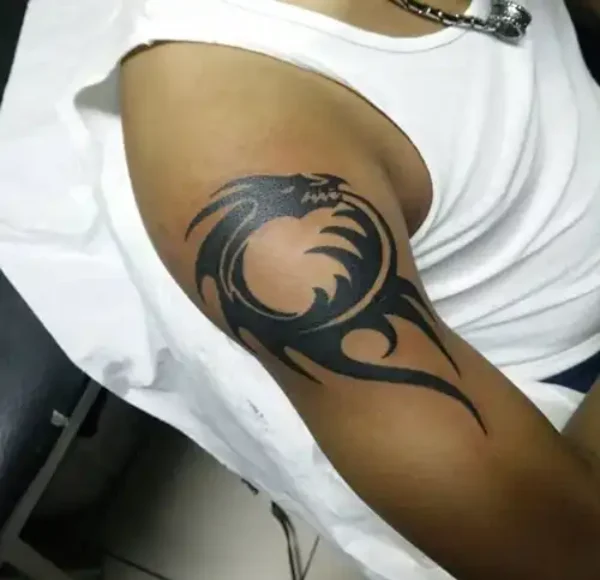
Bold Outlining
Old school tattoos are known for their bold black outlines. Tattoo artists use a thicker needle and a steady hand to create crisp, clean lines that define the design and give it a strong presence.
Solid Coloring
Traditional tattoos employ solid blocks of color without much shading or gradients. Tattoo artists use a technique called “packing” to ensure that the color is evenly distributed and saturated. This involves using a larger needle grouping to fill in the designated areas with solid color.
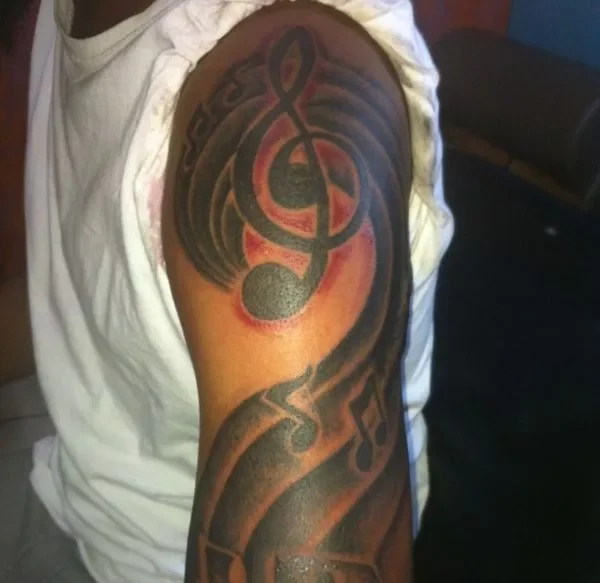
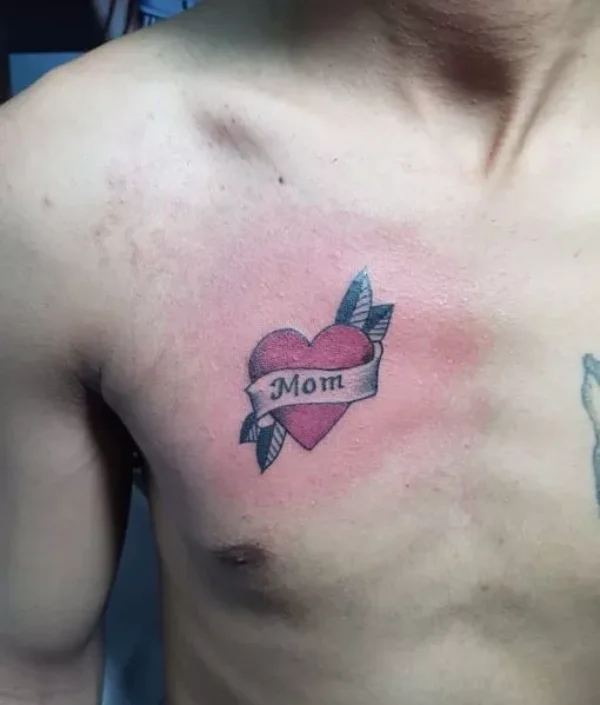


Limited Color Palette
Old school tattoos traditionally use a limited color palette, typically consisting of primary colors like red, blue, yellow, green, and black. These colors are applied in a flat, bold manner to achieve the classic old school aesthetic.
Pigment Density
To achieve the solid, vibrant colors associated with old school tattoos, tattoo artists focus on achieving a high pigment density. This means saturating the skin with a sufficient amount of ink to ensure the colors remain vibrant and don’t fade over time.
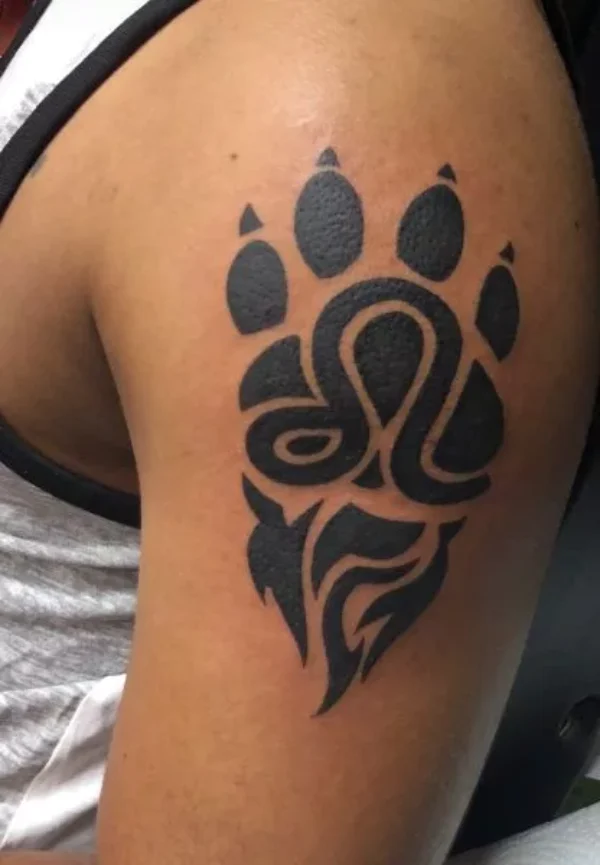


Use of Black
Black plays a crucial role in old school tattoos, both in the outlining and in creating contrast within the design. Bold black lines help define the tattoo, and areas of black shading or fill are often used to create depth and emphasis.
Minimal Shading
Old school tattoos typically feature minimal shading compared to other tattoo styles. Shading is primarily used to add dimension and contrast to certain elements of the design, such as banners, scrolls, or specific objects.
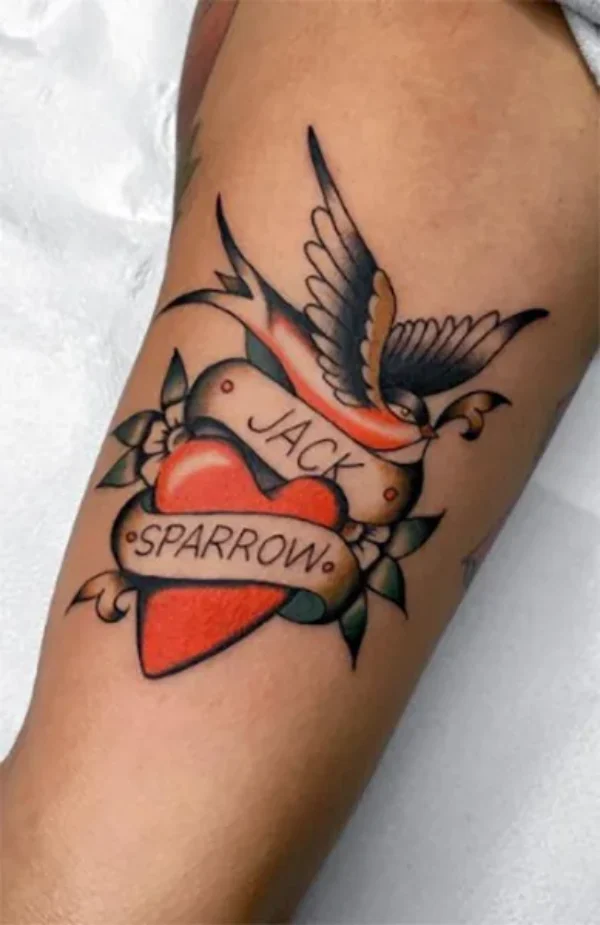


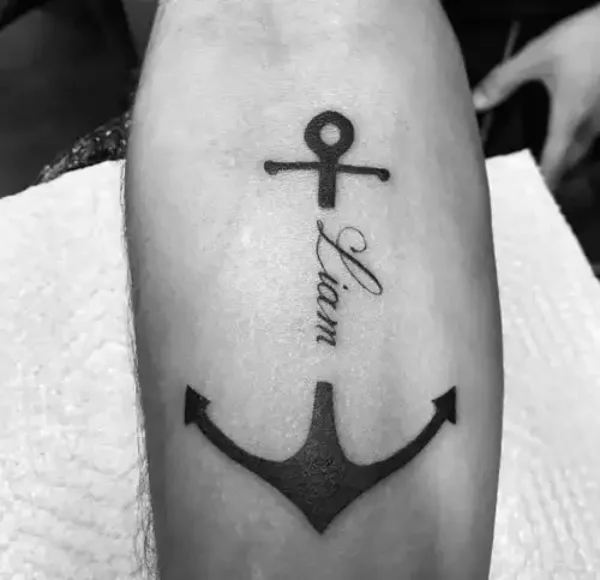


Traditional Design Elements
Tattoo artists specializing in old school tattoos often incorporate specific design elements associated with the style. These include iconic symbols like anchors, roses, hearts, swallows, nautical motifs, and patriotic themes.
It’s important to note that while these techniques are common in old school tattoos, tattoo artists may incorporate their own variations and adaptations to create unique pieces while still maintaining the overall traditional aesthetic.
Schedule Appointment
Old school tattoos Placement
Old school tattoos can be placed on various parts of the body, and the choice of placement often depends on personal preference, the size and design of the tattoo, as well as the visibility and significance one wants to give to the tattoo. Here are some common placements for old school tattoos:
- Arm: The upper arm, forearm, or full sleeve are popular locations for old school tattoos. These areas provide ample space to showcase larger designs such as anchors, roses, ships, or pin-up girls. The bicep area is often used for standalone designs, while the forearm and sleeve allow for more elaborate compositions.
- Chest: The chest area is a popular choice for old school tattoos, especially for bold and prominent designs. A classic placement is in the center of the chest, where a large design like an eagle, heart, or a traditional ship can be displayed. This area is particularly suitable for symmetrical designs or pieces that span across the chest.
- Back: The back provides a larger canvas for old school tattoos, allowing for intricate and expansive designs. A full back piece featuring nautical themes, mermaids, or a combination of various traditional elements is a common choice. Alternatively, smaller designs can be placed on specific areas of the back, such as the shoulder blades or lower back.
- Leg: Old school tattoos can be placed on the thigh, calf, or even the entire leg as a full leg sleeve. These areas can accommodate larger designs, such as a dagger, compass, or a pin-up girl. The calf is also a popular location for smaller standalone designs like anchors or swallows.
- Forearm and Wrist: The forearm and wrist are visible areas that allow for smaller old school tattoo designs. Common choices include individual symbols like hearts, anchors, or roses. The wrist is often adorned with smaller, delicate designs like a swallow or a small ship.
- Shoulder: The shoulder is a versatile location for old school tattoos. It can accommodate standalone designs or be part of a larger composition, such as a full sleeve that extends onto the shoulder. Popular designs for the shoulder include roses, skulls, or a traditional panther.
- Neck and Throat: For those looking for more daring placements, the neck and throat areas can be adorned with old school tattoos. These placements tend to be more visible and require careful consideration. Designs may include small symbols, words, or even a traditional swallow.
It’s important to consult with a professional tattoo artist to determine the best placement for your old school tattoo based on the design, size, and your personal preferences. They can provide guidance on how the placement will affect the overall look and longevity of the tattoo.
Old School Tattoos Healing and Aftercare
Proper healing and aftercare are essential to ensure your old school tattoo looks vibrant and lasts for a long time. Here are some guidelines to follow:
- Follow the artist’s instructions: At Rebel Inks Tattoo Removal and Piercing Palour we will provide specific aftercare instructions based on our expertise and the products we recommend. Listen carefully and follow our advice.
- Keep the bandage on: After getting your tattoo, at Rebel Inks Tattoo Removal and Piercings Parlour we may cover it with a bandage or plastic wrap. Leave it on for the time specified by your artist, usually a few hours.
- Clean your tattoo gently: After removing the bandage, wash your tattoo gently with lukewarm water and mild, fragrance-free soap. Use your clean hands, not a cloth or sponge, to avoid irritation. Pat it dry with a clean towel or let it air dry.
- Apply a thin layer of ointment: Once your tattoo is clean and dry, apply a thin layer of a tattoo-specific ointment recommended by your artist. Examples include A+D ointment or a petroleum-based product. This helps keep the tattoo moisturized and prevents it from drying out.
- Avoid picking or scratching: It’s crucial to resist the temptation to scratch or pick at your healing tattoo, as this can cause scarring, color loss, or infection. If it itches, gently tap or slap the area instead.
- Moisturize regularly: As your tattoo heals, continue applying a thin layer of ointment or switch to a fragrance-free, water-based lotion. Apply it 2-3 times a day to keep your skin hydrated and prevent excessive scabbing.
- Avoid sun exposure and swimming: Protect your healing tattoo from prolonged sun exposure, as UV rays can fade the colors. Additionally, avoid swimming or soaking the tattoo in water (pools, hot tubs, saunas) until it’s fully healed to minimize the risk of infection.
- Don’t wear tight or abrasive clothing: During the healing process, opt for loose-fitting clothing to prevent friction and irritation on your tattooed skin. Avoid materials like wool or rough fabrics that can cause discomfort.
- Be patient: Healing times can vary, but generally, it takes about 2-4 weeks for an old school tattoo to fully heal. Remember, each person’s healing process is unique, so don’t be alarmed if your tattoo takes a little longer.
- Follow up with your artist if needed: If you notice any signs of infection (excessive redness, swelling, pus, or prolonged pain) or have concerns about the healing process, reach out to your tattoo artist or a medical professional for guidance.
Remember, these guidelines are general recommendations, and it’s crucial to follow the specific instructions provided by your tattoo artist. Proper aftercare will help your old school tattoo heal beautifully and maintain its vibrant appearance for years to come.
Cost of Old School Tattoos
The cost of old school tattoos can vary widely depending on several factors. Here are some key considerations that influence the price:
Factors Influencing Cost:
- Artist’s Skill and Reputation: Highly skilled and well-known tattoo artists typically charge more for their work. An experienced artist with a strong portfolio in the old school style will likely have higher rates. At Rebel Inks Tattoos, Tattoo Removal, and Body Piercings Parlour we have experienced artists who offer quality and premium services.
- Location: Tattoo prices can vary significantly by location. Cities with a higher cost of living or a vibrant tattoo culture often have higher rates. Rebel Inks Tattoos, Tattoo Removal, and Body Piercings Parlour is located in the heart of the Central Business Disrict (CBD) in Nairobi, Kenya, and is easily accessible to both locals and foreigners in the country
- Tattoo Size and Complexity: Larger and more detailed tattoos require more time and effort, increasing the overall cost. Old school tattoos are often simpler, but the size can still play a major role in pricing.
- Shop Minimum: Many tattoo shops have a minimum charge, which can range from Ksh. 2,500 to Ksh. 10,000 or more, regardless of the tattoo’s size. At Rebel Inks Tattoos, Tattoo Removal, and Body Piercings Parlour our lowest rate for getting an Old School Tattoo is Ksh. 2,500 which is for the smallest Old School Tattoo. However, you can Get In Touch with us to discuss your specific Tattoo Requirement and how best we can structure a price that benefits us both.
- Hourly Rate: Some artists charge by the hour, with rates ranging from $100 to $250 or more per hour, depending on the factors mentioned above.
Estimated Costs:
- Small Tattoo: A small, simple old school tattoo (e.g., a small anchor or heart) might cost between Ksh. 2,500 and Ksh. 4,500.
- Medium Tattoo: A medium-sized piece (e.g., a rose or a swallow) could range from Ksh. 5,000 to Ksh. 7,000
- Large Tattoo: Larger pieces, such as a full arm or leg sleeve, can cost Ksh. 10,000 to several thousand shillings, depending on the detail and time required.
Additional Costs:
- Consultation Fees: Some of our artists charge a consultation fee, especially if custom artwork is involved.
- Touch-Ups: Touch-ups might be included in the initial cost or charged separately.
- Aftercare Products: Proper aftercare is crucial for tattoo healing, and the artist might recommend specific products.
Tips for Getting an Old School Tattoo:
- Research Artists: At Rebel Inks Tattoos, Tattoo Removal, and Body Piercings Parlour we haver artists who specialize in old school tattoos you can review our portfolios to see some of the custom designs we’ve done for a few of our clients.
- Consultation: Schedule a consultation to discuss your design ideas, get an estimate, and understand the artist’s process.
- Budget: Have a clear budget in mind, but be prepared for some flexibility based on the artist’s expertise and recommendations.
- Aftercare: Follow the artist’s aftercare instructions to ensure your tattoo heals properly and maintains its quality.
Other Tattoo Design
Get In Touch
For more information on the list above and any other special services,please call or come in for free consultation
Testimonials
Shout out to Eric😘
We ended up changing the jewelry three times to ensure I had the best fit and avoided any signs of rejection, and he always listened to my suggestions as a client, which I really appreciated. Now, three months in, my piercing is healing beautifully, with no sign of rejection. Highly recommend for anyone who values a piercer who cares about your comfort and healing journey!
The piercing wasn't as painful as I had thought and the process was quick and satisfactory. I love it!!!
The piercing is healing well thanks to the aftercare instructions and follow-up. I would highly recommend Rebel Inks
Eric also did a belly button piercing for a friend, guiding her through the process, doing the piercing and then explaining the after care to her.
The shop is on the 3rd floor, with the entrance to the stairs near an alleyway on the left. The shop is perfect size, clean, and attractive looking. The mural is pretty dope.
Thank you for the amazing service! 🔥👅✨
I got piercibgs there and the process was really good. My biggest concern was hygiene but that wasn't an issue at all, they use new needles and they sanitize them.
The service itself was also welcoming.
I was informes of everything i needed to know beforehand.
10/10 would recommend!
Eric was so calm and patient with my almost 2 year old lady. It was such a clean and hygienic process. We will definitely be back for our second rounds of piercings and maybe even another tattoo!
They assess the area before any art and advise one accordingly. They also give one post clean up process and also do a check up after the body art projects. Overall, I loved my experience and I’m hooked. 👍
Will definitely come back next time I’m in town 🙂
He listened to what I actually wanted and made sure he could fit in the time before I flew back home.
The shop is clean & private and is easy enough to find.
Eric has even checked in a couple of times since to make sure all is good.
I would totally recommend Eric! I absolutely love my Elephants!
I had a very easy healing period and always follow up from Eric to check on my progress...I would highly recommend if you are a first timer because from my experience all went very well and attention to detail
Thank you for a good job and looking forward to send all my friends your way
And all the best with the new year 2025!
From the moment I walked in, the staff was super friendly and made me feel at ease. The studio had a clean, professional atmosphere, which immediately put me at ease. My piercer was incredibly skilled and explained every step of the process, ensuring I was comfortable the entire time. The piercing was quick and practically painless, and the aftercare instructions were clear and easy to follow. I can tell they really care about the health and safety of their clients.
Overall, a fantastic experience—I highly recommend Rebel Inks and Tattoos for anyone looking to get pierced or tattooed!
They do follow up after their services
Eric's Studio isn’t just a place to get a tattoo—it’s an experience. The combination of professionalism, artistic talent, and a welcoming environment makes it a standout destination for anyone considering a tattoo.
I highly recommend Eric’s Studio to both first-timers and seasoned tattoo enthusiasts. If you’re looking for a high-quality tattoo and an enjoyable experience, this is the place to go.
I would definitely recommend their services again and again
Thank you Rebel Ink
My piercings are healing ❤️🩹 well
I would 💯 recommend
I will definitely come back for more .
Two, all the equipments he used for the piercings were new and/or sterilised.
Three, the parlour itself was very clean and was up to par with the hygiene standards.
Four, Eric provided effective aftercare instructions, making sure I knew exactly how to take care of my new piercings and he kept in touch and continues to do so, to check on the healing progress.
I highly highly highly recommend this place!!!
Would definitely recommend them to friends and go back for other piercings
Not only was the piercing process smooth, but he also provided thorough aftercare instructions, making sure I knew exactly how to take care of my new piercings. What really impressed me was that he keeps in touch to check on how the healing is progressing – a sign of true care for his clients.
The shop maintains a high standard of hygiene, and the atmosphere is welcoming and comfortable, which really added to the positive experience. I highly recommend this place to anyone looking for a professional and caring experience. I’ll definitely be coming back for any future piercings!
My appreciation for the excellent customer service I received. The follow-ups were prompt, and I truly appreciated the gentleness and professionalism throughout. Thank you!"
"Looking for professional eyebrow microshading removal? Look no further!"
The customer care is top tier 👌🏾👌🏾.
Wonderful place to get tattoos and piercings. 💯💯
Eric goes ahead to follow up on his clients progress and gives good advice each time I reach out to him.
I would recommend Reble tattoos anytime.
Good job bro we really appreciate.
Ohh and the price is very fair.
The environment was clean , procedure was sterile and the jewelry used are of the best quality.
He followed up with me during the healing process, he educated me on what I needed to do for my aftercare.
Eric is confident, skilled , experienced and the best piercer. Highly recommend Rebel inks.✨
Definitely recommend!
Great experience.
Eric definitely know what he is doing .
I got exactly what I wanted 2 tiny tats on the same finger .
He was kind and patient throughout the session.
Healing process has been good .
Aftercare services were given and regular checkups on the healing process were done.
I would 💯recommend.
Eric gave me the best reception as it was my first time there,and made me trust him all the way. I appreciate good services.
There services are also affordable not to forget 😊.
He was also invested in the aftercare and would ensure I follow the do's and don'ts in taking care of the tattoo and ensuring proper healing and maximum ink retention.
Would highly recommend Rebel Inks Tattoos.
Rebel Inks Tattoo offer the best,affordable and quality tattoo removal services.If you have unwanted ink,choose Rebel Inks Tattoo,they're the best of the best and the professionalism is a top notch.They ensure you're free from unwanted ink with their Laser Tattoo Removal Technology...
I did a Laser Tattoo Removal with them and i can attest they're the best....
Kudos Eric...
I highly recommend.
It was a generally good experience with good hygiene during the piercing process and has been a smooth healing process.... 10/10
tips. Highly recommend 👍🏽
100% recommendable.
I was particularly impressed with Eric's attention to hygiene. He thoroughly cleaned the room before I entered, sanitized all of the equipment he would be using, and changed gloves between each ear. This level of cleanliness gave me great confidence in his professionalism.
Eric's commitment to customer service did not end on the day of the piercing. He followed up with me regularly throughout the healing process to ensure that I was following the aftercare instructions and that my earlobes were healing properly.
I highly recommend Rebel Inks to anyone in Nairobi who is considering getting a piercing. Eric is a highly skilled and experienced piercer who takes great pride in his work.
So I Check all the boxes below and more:
Customer Care: ✔️
Professionalism : ✔️
Cleanliness ✔️
Price: ✔️
After care service ✔️
Thanks and good job, Eric
The place is neat and clean and the equipments he used were also fine standards. Really appreciate his following up with me on the healing 🤗
I WOULD HIGHLY RECOMMEND THEIR SERVICES to everyone. Actually what you see on their website is EXACTLY what you will get. Keep up the good work Rebel inks Tattoos.
The infection is now gone. I would definitely recommend!
Can recommend this place totally and would go back there anytime!
Thanks!
OUR LOCATION
Areas We Serve
NAIROBI
KIAMBU
KAJIADO
MACHAKOS
